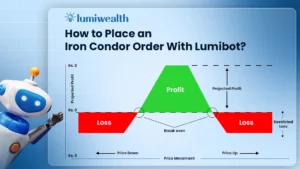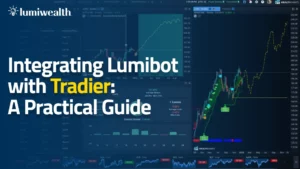Introduction
With the rise in popularity of options trading and the increase in the use of algorithmic trading, more and more traders have started using Options Trading Bots. Not only can options trading bots remove issues like emotional bias, as is the case in manual trading due to various factors like overconfidence, greed, fear, and personal sentiments towards trades, but they can also protect traders from illogical decision-making, increased risks, and a shattered portfolio, which can otherwise result in losses. Unlike human traders, bots don’t require rest, which allows them to respond to market events in real time, even when the traders are not actively monitoring the markets. Whether you employ a covered call strategy or any other, options trading bots can help you optimize your approach by endlessly monitoring market fluctuations and adjusting your holdings as per the requirements.
When it comes to algorithmic trading, there has always been a demand for a user-friendly library that supports options or any other derivative instrument. Built using Python, Lumibot is one of the top trading libraries for a wide array of derivative instruments, including options trading. With its backtesting and live trading feature, it is a fully-featured, superfast library that allows you to easily create profitable trading robots in many different asset classes.
Let’s find out how to build an options trading bot using Lumibot and take your trading business to new heights.
However, before getting into the nitty-gritty, let’s find out the factors to consider when creating an options trading bot.
Factors to Consider When Creating an Options Trading Bot
Let’s face it, maintaining an edge is of utmost importance in the ever-changing world of options trading. Given the unpredictable market dynamics and the constant nature of the trading market, traders are progressively adopting trading bots driven by Artificial Intelligence (AI) to streamline their strategies and increase their earnings. However, when it comes to making an options trading bot, there are a number of elements that you need to take into consideration. Read on to find out the factors to consider while developing the Options trading bot.
Define Your Strategy
It goes without saying that even excellent trading strategies can result in significant losses, whether in the bullish or the bearish market. It is important to understand the market beforehand to sort out its current state and what a trader can expect in the near future. Needless to say, a good strategy is essential for the success of the trading bot. When it comes to creating an options trading bot, selecting the right strategy is hence essential. If the trader selects the wrong strategy, they can end up with losses and expenses, which can lead to severe setbacks in their trading business. Furthermore, the strategy must be backtested appropriately and results verified by an economic expert before going live trading.
Optimize Your Trading Bot
In addition to defining your strategy, you also need to optimize the strategy used in the trading based on backtesting results to increase profit, though it is also required to face fierce competition. After initial backtests, the strategy’s parameters or rules can be optimized to enhance performance. Factors like risk management, automation, speed, and efficiency can be considered during the optimization of the trading bot.
Select the Right Trading Platform
Choosing the right trading platform can make or break your trading bot. As traders, you must select a platform that meets your needs, provides easy-to-use tools and customer support, charges less commission, and ensures security and stability.
Proper Use of Parameters
When it comes to developing an Options trading bot, parameters like entry price, exit price, stop losses, take profit prices, and various others should be used after deep research as these inputs are crucial for your trading strategy’s success. Furthermore, there should be deep research on underlying strengths, expiry, and premium to set entry, hold until expiry, and price movements to decide the adjustments in stop losses.
Steps to Create an Options Trading Bot Using Lumibot
Building an options trading bot using Lumibot involves several steps, like defining your strategy, setting up the necessary infrastructure, coding the bot, and testing the bot completely. From determining the parameters to writing trading strategy algorithms using derivative instrument fundamentals, you have to keep in mind several factors. Listed below are the steps to create an options trading bot using Lumibot.
Prerequisites
Before creating an options trading bot using Lumibot, you need to ensure the following prerequisites:
Setting Up Lumibot
- Ensure you have Python installed on your PC.
Note 1: Users can download the most recent stable version of Python from here.
Note 2: For the screenshots below, we used Pycharm as an IDE.
Check the Python version using command: Python –version
Python –versionOnce you have downloaded and installed Python, install Lumibot using pip: pip install lumibot from the terminal.
pip install lumibot Choose a broker that supports options trading and Lumibot integration (e.g., Interactive Brokers). You are not required to do anything for this, as Lumibot will automatically do this for you.
Options Bot – Backtesting & Live Trading
Step 1 – Lumibot Strategy Code
When it comes to creating an options trading bot using Lumibot, start writing the code as shown below.
Note: The strategy that is being discussed here is the Long Call Option Buy and Hold until Expiry strategy, which is implemented using the Lumibot.
Step 1.1 – Imports and Initial Class Definition
To start building the strategy, simply Import the classes as shown below:
from datetime import datetime
from lumibot.entities import Asset
from lumibot.strategies.strategy import Strategy
"""
Strategy Description
An example strategy for buying an option and holding it to expiry.
"""
Imports and Comments
Asset: Represents a financial instrument like a stock or option.
datetime: Used for handling date and time, especially for option expiry dates.
Strategy: Base class for creating trading strategies in Lumibot.
Docstring: Provides a brief description of the strategy.
Step 1.2 – Strategy Class Definition and Parameters
Once you have imported the classes, define the parameters and provide the class definition for the OptionsHotdToExpiry class, as below.
IS_BACKTESTING = True # Flag to indicate live trading or backtesting
BACKTESTING_START = datetime(2023, 06, 24)
BACKTESTING_END = datetime(2024, 06, 24)
class OptionsHoldToExpiry(Strategy):
# Define parameters for the strategy
parameters = {
"buy_symbol": "SPY", # The symbol of the asset to buy
"expiry": datetime(2024, 10, 20), # The expiry date of the option
}
Class Definition and Parameters:
OptionsHoldToExpiry inherits from Strategy.
buy_symbol: The ticker symbol of the asset to purchase options on.
expiry: The expiration date for the options.
Step 1.3 – Initialize Method
Once you have provided the class definition and parameter details, provide the implementation code for the initialize method with initial variables and constants.
def initialize(self):
# Set initial variables or constants
# Built-in variable for the sleep time between iterations
self.sleeptime = "1D" # Sleep for 1 day between iterations
initialize Method:
Called once at the start of the strategy.
self.sleeptime: Sets the interval between each trading iteration to 1 day.
Step 1.4- on_trading_iteration Method.
The following method is executed to buy the traded symbol once and then never again. So, this method is only invoked once.
def on_trading_iteration(self):
"""Buys the self.buy_symbol once, then never again"""
buy_symbol = self.parameters["buy_symbol"]
expiry = self.parameters["expiry"]
# What to do each iteration
underlying_price = self.get_last_price(buy_symbol)
self.log_message(f"The value of {buy_symbol} is {underlying_price}")
if self.first_iteration:
# Calculate the strike price (round to nearest 1)
strike = round(underlying_price)
# Create options asset
asset = Asset(
symbol=buy_symbol,
asset_type="option",
expiration=expiry,
strike=strike,
right="call",
)
# Create order
order = self.create_order(
asset,
10,
"buy_to_open",
)
# Submit order
self.submit_order(order)
# Log a message
self.log_message(f"Bought {order.quantity} of {asset}")
on_trading_iteration Method:
Called on each trading iteration.
Retrieves buy_symbol and expiry from parameters.
Gets the last price of the asset and logs it.
On the first iteration:
Calculate the strike price by rounding the last price.
Creates an Asset instance representing the option.
Creates an order to buy the option.
Submit the order.
Logs the purchase.
Step 1.5 – Main Block for Running the Strategy
Finally, write the main block, which handles the entire operation based on the constants and variables, i.e. if IS_BACKTESTING = TRUE Then, the bot will do the backtesting, or otherwise, it will do the live trading. In this block, you also need to pass the configurations from your broker or the Polygon.io API key. Polygon.io provides the historical data for backtesting.
if __name__ == "__main__":
from lumibot.backtesting import PolygonDataBacktesting
# Define the backtesting period
# Run backtesting on the strategy
results = OptionsHoldToExpiry.backtest(
PolygonDataBacktesting,
BACKTESTING_START,
BACKTESTING_END,
benchmark_asset="SPY",
polygon_api_key="Mention API Key here", # Add your polygon API key here
)
Main Block:
Determines whether to run the strategy live or in backtesting mode based on the is_live flag.
Live Trading:
Imports credentials and modules for live trading.
Creates a Trader and InteractiveBrokers instance.
Initializes the strategy with the broker.
Adds the strategy to the trader.
Runs all strategies.
Backtesting:
Imports the module for backtesting.
Defines the backtesting period.
Runs backtesting on the strategy with specified parameters and logs the results. Developers need to create an account in Polygon.io and paste the API key from there above for backtesting.
Backtesting or Live Trading
Lumibot allows you to backtest your strategy using historical data as well as run it for live trading.
Backtesting
Polygon.io provides the historical data for any mentioned time period (historical data), and we need to create a free account for it, as well as add the API key in the main code and run the code in Pycharm, a popular IDE for Polygon.io.
Live Testing
The code snippet above initializes Lumibot for live trading with Interactive Brokers (IB).
Below are the details:
Conditional Check:
if is_live:: It is first required if the is_live is true. The program will run for live trading if this is set as true.
The INTERACTIVE_BROKERS_CONFIG variable contains the Interactive broker’s account credentials. It’s not shown in the code above as we are not performing live trading here. The live trading will be discussed later in some other blog.
from lumibot.brokers import InteractiveBrokersThis line imports the InteractiveBrokers class from the lumibot.brokers module, and this caters to the developers an interface to connect with IB.
from lumibot.traders import TraderThis line shows how the developers can import the Trader class from the lumibot.traders module. Remember it is the Lumibot that manages the execution of trading strategies.
Live Trading Objects:
trader = Trader()This line is required for the creation of the Trader object, which is necessary for running the trading strategies.
broker = InteractiveBrokers(INTERACTIVE_BROKERS_CONFIG)This line is written for the creation of the InteractiveBrokers object, ensuring the connection and communication with the developer’s IB account with the help of the Interactive broker credentials.
Strategy and Trader Setup:
strategy = OptionsHoldToExpiry(broker=broker)This is how an instance of a strategy named OptionsHoldToExpiry can be created. This strategy focuses on buying options and holding them until expiry. The broker argument ensures the connection to your IB account for the execution of the order.
trader.add_strategy(strategy)This line is written for adding the created OptionsHoldToExpiry strategy to the Trader object. For a trader its possible to manage multiple strategies in parallel.
Live Trading Execution:
strategy_executors = trader.run_all():This line initiates the live execution of the trading strategies managed by the Trader object. Since InteractiveBrokers is used as the broker, trades will be placed on your IB account based on the logic of the OptionsHoldToExpiry strategy.
Important Note: Make sure your IB account credentials are secure. You can do this by storing such sensitive details in a separate credentials.py file, which should not be shared and likely uses secure methods to store your keys. If we add this in gitignore, it will not be shared while we share the code through a GitHub account.
Conclusion
In the fast-paced world of options trading, where market shifts occur around the clock, traders are seeking new ways to optimize their strategies and boost their profits. The emergence of options trading bots has provided a powerful solution to navigate this dynamic landscape. Developed by expert developers and financial experts at Lumiwealth, Lumibot can help traders build a trading strategy that can help them beat the fierce competition. From the ability to operate non-stop and manage multiple markets to the precision and speed of execution, options trading bots created using Lumibot provide a level of efficiency that is challenging to achieve with manual trading. With minor programming skills, traders can develop an outstanding trading bot using different derivative instrument concepts to make a fortune that can help them ensure a good life for their families. So, what are you waiting for? Register for our paid training classes on our website, or attend free classes to confirm what we have for you here: lumiwealth.com/2-hour-algo-slo-page-current




